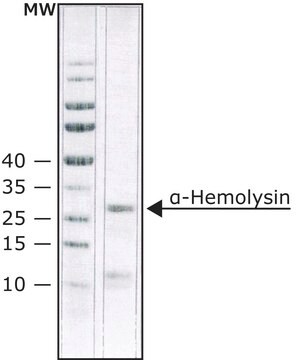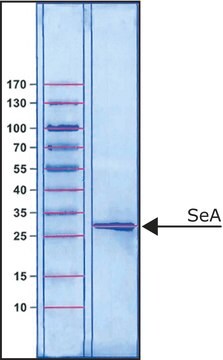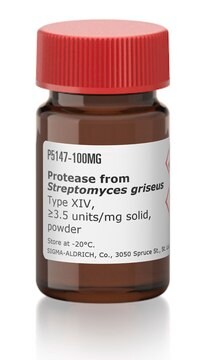T5319
Tetanolysin from Clostridium tetani
Se connecterpour consulter vos tarifs contractuels et ceux de votre entreprise/organisme
About This Item
Produits recommandés
Source biologique
Clostridium tetani E88
Poids mol.
55 kDa
Application(s)
cell analysis
Température de stockage
2-8°C
Informations sur le gène
Clostridium tetani E88 ... CTC01888(1060232)
Description générale
Hemolytic activity of tetanolysin is determined using 2.5% rabbit red blood cells at 37 °C for 40 min.
Application
Tetanolysin has been used to analyze the formation of lytic pores in red blood cells (RBCs)1. It has also been used to permeabilize infected RBCs2.
Actions biochimiques/physiologiques
Cholesterol-binding toxin used to permeabilize cellular membranes to enhance the entry of macromolecules into the interior of the cell. Pores induced reported to be in the range of 20-50 nm.
Cholesterol-binding toxin used to permeabilize cellular membranes to enhance the entry of macromolecules into the interior of the cell..
Notes préparatoires
Prepared by a modification of the method of Haque, et al.
Reconstitution
When reconstituted with 100 μl of sterile water the concentration is 1 μg/μl in 40 mM sodium phosphate buffer, pH 7.2, containing 200 mM NaCl.
Remarque sur l'analyse
Single band by SDS-PAGE.
Code de la classe de stockage
11 - Combustible Solids
Classe de danger pour l'eau (WGK)
WGK 3
Point d'éclair (°F)
Not applicable
Point d'éclair (°C)
Not applicable
Équipement de protection individuelle
Eyeshields, Gloves, type N95 (US)
Faites votre choix parmi les versions les plus récentes :
Déjà en possession de ce produit ?
Retrouvez la documentation relative aux produits que vous avez récemment achetés dans la Bibliothèque de documents.
Hayley E Bullen et al.
The Journal of biological chemistry, 287(11), 7871-7884 (2012-01-19)
To survive within its host erythrocyte, Plasmodium falciparum must export hundreds of proteins across both its parasite plasma membrane and surrounding parasitophorous vacuole membrane, most of which are likely to use a protein complex known as PTEX (Plasmodium translocon of
Jason W Rosch et al.
The Journal of clinical investigation, 120(2), 627-635 (2010-01-23)
Sickle cell disease (SCD) is characterized by intravascular hemolysis and inflammation coupled to a 400-fold greater incidence of invasive pneumococcal infection resulting in fulminant, lethal pneumococcal sepsis. Mechanistically, invasive infection is facilitated by a proinflammatory state that enhances receptor-mediated endocytosis
Notre équipe de scientifiques dispose d'une expérience dans tous les secteurs de la recherche, notamment en sciences de la vie, science des matériaux, synthèse chimique, chromatographie, analyse et dans de nombreux autres domaines..
Contacter notre Service technique








